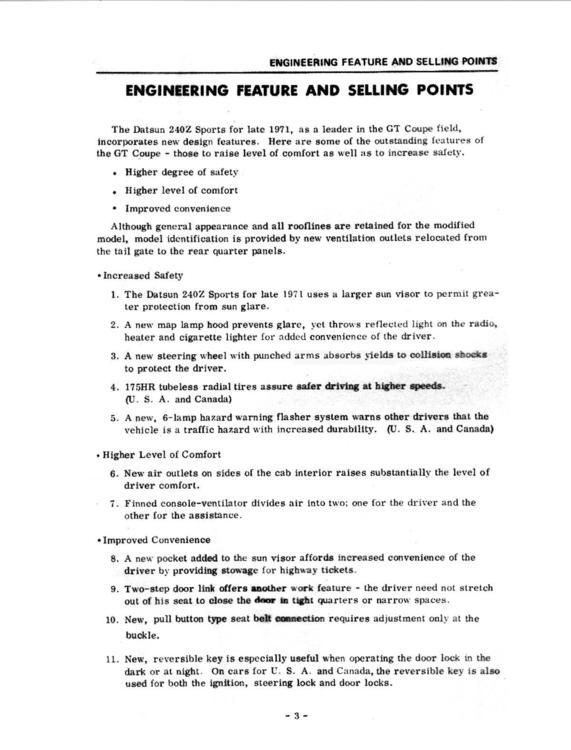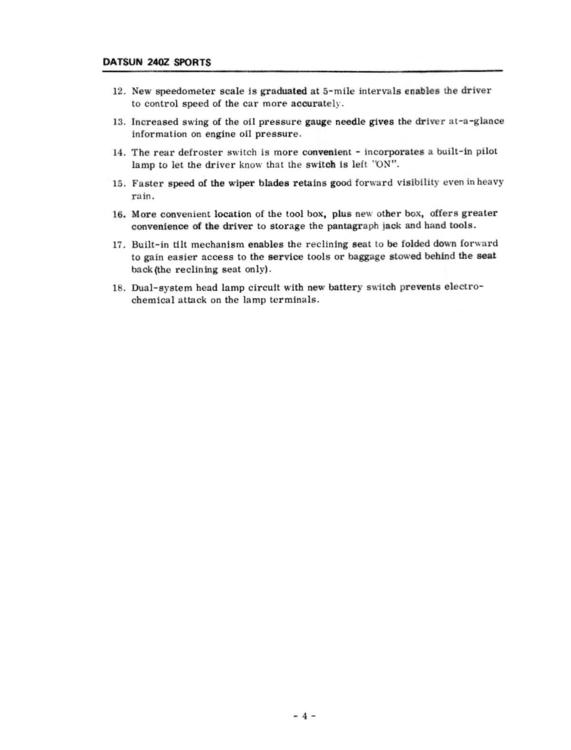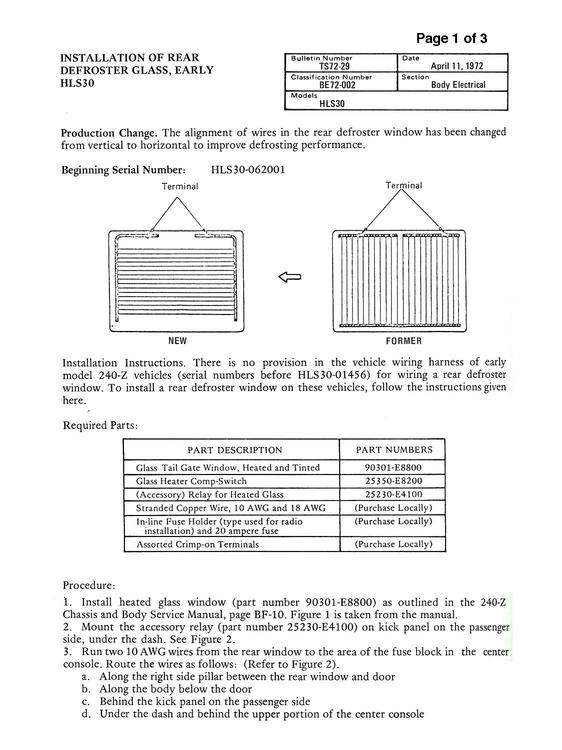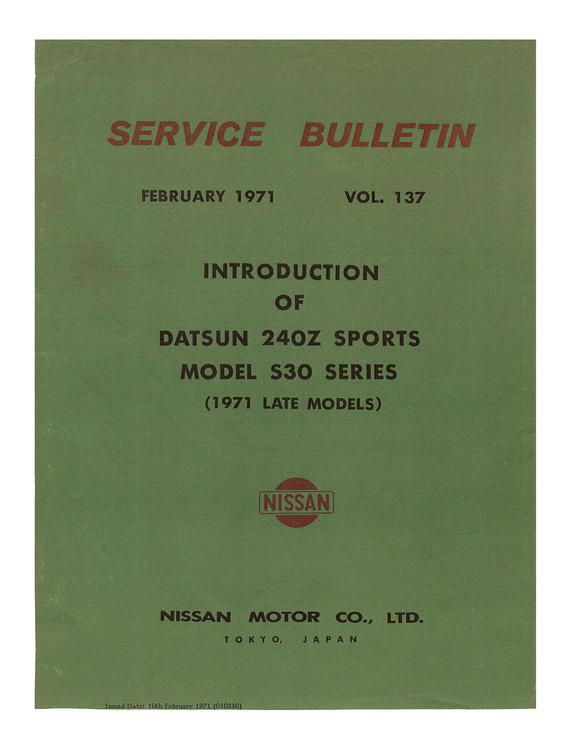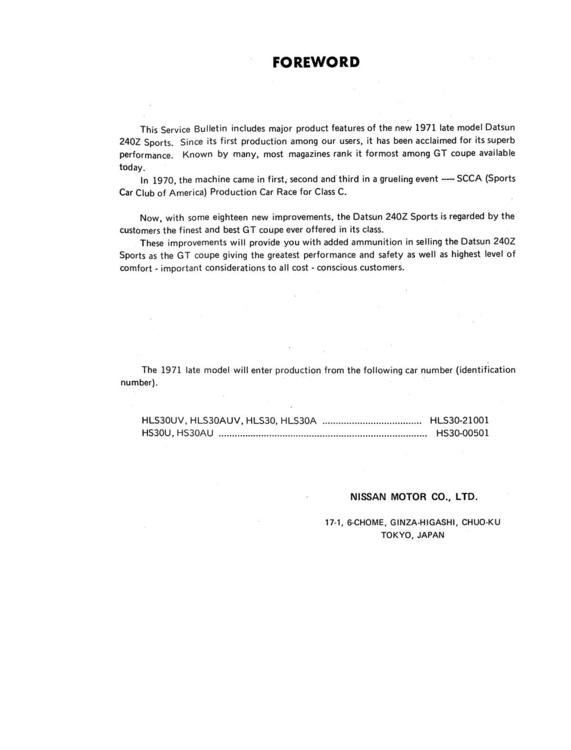Everything posted by Carl Beck
-
Early vs. Late Series I 240Z's
According to Nissan, some 18 new improvements were incorporated into the 1971 LATE MODELS - aka Series II - the second series of chassis serial numbers starting at HLS30 21001 and HS30 00501. All 18 of these improvements were made at the Model Change Over.
-
Early vs. Late Series I 240Z's
-
Mint '71 240Z - More Fun Coming to BaT
As the sticker says - "Vehicle Emission Control Information”- - it is not a performance spec. Customers that wanted a performance tune knew what to do. Still in several States they had to pass annual vehicle emissions tests to keep their cars registered for road use. Customers in the USA wanted cleaner air and the largest Customer Base that was almost fanatics about it was in California; where some 20,000,000 people were choking on pollution almost monthly. California lead the demand for the reduction of automotive exhaust gas pollution, with their California Air Research Board setting State Level Standards, restricting exhaust gas pollution and gasoline vapor pollution over and above the USA Federal Standards which were the strictest enforced in the world. So for daily driving a Sports/GT Customers were more than happy to give up a couple HP for cleaner air; especially in a car where losing a couple HP wouldn’t even be noticed in day to day traffic.
-
Mint '71 240Z - More Fun Coming to BaT
Chris, I'd say they were five digit serial number up to 100000 - - HLS30 100095 had a date of Mfg. of 08/72 and the highest VIN for a 72 Model we have found so far is #101398 in Portugal.
-
Mint '71 240Z - More Fun Coming to BaT
While the Date Range is wrong - the chassis serial number ranges are correct according to the Service Bulletins.
-
Mint '71 240Z - More Fun Coming to BaT
I certainly did not coin the term - I’m not that OLD! The use of Series designations to distinguish one model from another of various Marques, when confusion existed because of terms like “Model Year” - has been around and in use among auto enthusiast since I can remember. The E-Type’s for example used Series I & 2 when both models were sold with the same Model Year designation back in the early 60’s. (Some say Flat Floors) So nothing new there. Series designations were applied to the Datsun 240Z’s by enthusiasts not to long after Nissan sold the same model as both 1970 & 1971 Model Year vehicles, long before the Internet. We know there is a large overlap in the Registrations and Titles of 1970 &1971 Model Year examples. The first, second, third and fourth Series of Chassis Serial Numbers for Datsun 240Z’s are all specifically identified by Nissan in their Technical Service Bulletins. There are four specific VIN number series used to identify them.(one VIN series for Left Hand Drive and another VIN series for Right Hand Drive). Nissan issued Technical Service Bullets listing the beginning VIN chassis serial number series (Vehicle Information + Chassis Serial Numbers) as well as what Nissan considered major improvements to Safety, Comfort and Convenience of each - all introduced at the same time on the subsequent series. For HLS30 models: The First Series of Chassis Serial Numbers Sold to the Public - VIN’s HLS30 00013 The Second Series of Chassis Serial Numbers - VIN’s HLS30 21001 The Third Series of Chassis Serial Numbers - VIN’s HLS30 46000 The Fourth Series of Chassis Serial Numbers - VIN HLS30-120001 For HS30 models The First Series of Chassis Serial Numbers Sold to the Public started with HS30 00003 (from Oct.69) The Second Series of Chassis Serial Numbers - HS30 00501(from Jan 71) The Third Series of Chassis Serial Numbers - HS30 01501 (from Sep. 71) The Fourth Series of Chassis Serial Numbers - HS30 14001 (from July 72) Nissan listed some 17 or 18 specific Safety, Comfort and Convenience Features introduced on the Second Series of HLS30 production for North America, starting with VIN HLS30 21001 . These were not changes to minor parts during the production run, nor changes to part numbers made throughout the calendar year. These were improvements you got for buying the New & Improved Model being released and not found on the earlier one. See: SERVICE BULLETIN, February 1971, Vol. 137 INTRODUCTION OF DATSUN 240Z SPORTS MODEL S30 SERIES” (1971 Late Models) Likewise the New Model Introduction - Technical Service Bulletins - issued by Nissan list the significant changes for the third and fourth Series of production. Several of these Nissan Technical Service Manuals are now available in digital form on line.
-
I've been looking for a project
About the plastic guide rollers on the ends of the lift arms - A friend of mine took his regulators to a local Machine Shop - they removed the original rivets and found plastic guide rollers that would work -then riveted the new one’s back on. You could also use a bolt on type - just cut the bolt off and spot weld.. Something like these… https://www.mcmaster.com/track-rollers With 50 year old cars - sometimes you just have to make the part.. good luck, Carl
-
I've been looking for a project
Most of the time - the problem with windows rolling up/down are caused by the felt pads and seals in the window door frames. You have to take the door apart - pull the window frames out - and replace the felt and rubber seals. Many times the plastic rollers on the window lift will be gone as well.. but cleaning and new grease will solve most problems.
-
I've been looking for a project
Fresh Tires close to the original size will work wonders for both ride and handling. 195/70x14's - 205/60x15's will work, but steering is a little harder and wider tires tend to "track" or follow the road more. Very important to assure you have good bushings in the Tension/Compression rods. KYBs are good if you can still get them, Tokico gas pressures are fine as well. Stock spring rates are fine, a slightly larger diameter front anti-sway bar improves handling without having too much effect on ride quality.
-
2019 ZCCA Branson
Just an FYI - - https://www.wsj.com/articles/when-datsun-met-corvette-sparks-flew-11569942100 Carl B.
-
Pikes Peak trip!
Thanks for the Travelog @Dave WM - Hats Off to you for venturing out on the journey! Now I'm wondering what inspired the trip to begin with? Carl B.
-
Mr.Uemura wrote a book "making story of a Fairlady-Z"
However - nothing ever seems to work out so simply. I believe that there are good reasons no one initially said - “Hey lets put that big engine in that car”. Mr.Idia revealed in an interview with Nostalic Hero Magazine that he started development of an in-line six cylinder engine in July of 1964. The purpose of this was to compete with Toyota, which already had a six cylinder engine in the Toyota Crown. In order to catch-up with Toyota Mr. Idia’s team, in the Large Engine Development section was given only one year to develop the L20. The L20 was introduced in Oct. of 1965 in the Cedric. Mr. Idia tell us that the fastest way to develop an in-line six cylinder engine, was to use an existing 4 cylinder block and add two cylinders. Which he did. He said he liked the Mercedes Benz OHC and chain driven valve train - so he used that. Because of the rushed development, and shortened evaluation cycles, the L20 suffered from several problems. Some problems were found during endurance bench testing, others showed up later on road testing and as customers put more miles on them and made complaints. The L20 obtained high power of 115ps by using SU twin pots, in order to compete with the Prince six cylinder engines that already existed. However here were problems with engine component parts suffering premature failures. The output adjustment of two carburetors was difficult and the idle speed was so high it resulted in increased fuel costs. Customers complained about this. Larger oil consumption was another problem due to bad valve guides, valve stem oil seals and oil rings. The engine was improved one year later to solve some of these problems - maintenance was improved and they used a single down-draft carburetor, but max power was reduced to 105ps. The improved L20A was the result of engine development having been turned over to the Small Engine Development team, after they developed the L16 for the Datsun 510. The L16 benefited from a complete development cycle, so the L20A used the improvements from the L16 and added two cylinders to that. All these problems resulted in the L20 being a short lived engine, and they were known to the people within Nissan. I can’t see them planing on using an engine that was going out of production. I can see them planing on using the new L20A as it was based on the successful L16 and in development within the Small Engine Group at the time. Executive management wanted to use the new Price S20 and Mr. K knew the L24 was coming. Mr. K was responsible for getting the L16 designed and put into production for the 510 for America. Nostalgic Hero, Vol. 102, April 2004 http://zhome.com/DatsunLSeries/L20NH2004April.htm English translation: http://zhome.com/DatsunLSeries/L20NH2004AprilTrans.htm
-
Mr.Uemura wrote a book "making story of a Fairlady-Z"
Hi Kats: Mr. Hara was also part of the team that brought the first Datsun’s to America in 1958, to see if Datsun’s could be sold here. It was a four member team. Nobe Wakatsuki (Marubeni Trading Co.) and 3 Nissan Engineers: Teiichi Hara (Senior Member of the group) Kuniyuki Tanabe (a disciple of Gorham) Shin Maki If you haven’t read it - David Halberstam’s “THE RECKONING” is a great book about Nissan/Ford. One Chapter “The Victory” (racing with a VW) is devoted to the team that brought Datsun to the USA in 1958. Mr. Hara is one of the people that advised Mr. K to take the assignment in America, to do a market survey in 1960. When ask in 1996 who designed the Z Car - Mr. K responded as shown here: http://www.zhome.com/MrKLetterToBill.jpg FWIW, Carl B.
-
Mr.Uemura wrote a book "making story of a Fairlady-Z"
Hi Kats:I think #2 and #3 are correct. No question that Executives in Japan wanted the S20 for the Sports Car in Japan as Mr. Uemura reports. Mr. Matsuo however tells us that as well in his Z Car Story, only Mr Matsuo reports that Mr. K wanted the L24 for America - so Mr. Matsuo ask what 2.0 liter engine would be used for Japan, and was told to use the S20. So before the Z left the styling studio - it was designed to hold both 6cylinder engines. Then is was up to the Vehicle Development Dept. to figure out how and get it done. Mr. Matsuo writes: = = Quote = = "A Prototype Based On 'Plan A' From 1967, work began in earnest producing full-sized clays based on the Plan A proposal. One of the key Z styling features evolved during this period, namely the "sugar scoop" headlights. The SAE regulations stated they should be 60cm from the ground, but plastic covers were not allowed in America at the time. However, we offered the latter item as an option in Japan. The final clay we produced was very close to the ultimate shape of the Z. Although the body was still a touch narrow, the roofline a little too high, the bonnet much too low to accept the six-cylinder L24 engine, and there remained a lot of detailing to do around the windows and tail-end, I was basically happy with the result By coincidence, at the time of its completion, Mr Katayama was back in Japan to see the 5I0 before It was launched. During his visit, he asked to see the next generation sports car, so we lined up the various clays (including the early ones depicting convertibles), and his eyes went ~- straight to the last one we had built. He said this was just what he needed in America. With Mr Katayama's support, the project finally started to progress and the engineering department became involved. Eventually, by the early Autumn of 1967, we had produced a glassfiber prototype. It was allocated the 'Z' designation (an appellation that would stay with the car throughout its production life). However, when the technical staff arrived to discuss the project, we found a number of problems. Mr Katayama had requested the 2.4 liter L24 power-plant, while the Japanese market had exorbitant taxes on vehicles over 2,000cc. Nissan had just taken over the Prince concern, and we were told to use their two-liter S20 twin-cam unit (this eventually became the famous Z432 model, incidentally). These powerful engines would require a stronger transmission. and the automatic version of the L24-equipped model required a much wider transmission tunnel: this in turn led to a reduction in interior space, so the only solution left open to us was to increase the width of the body. At the same time, the bonnet height had to be altered to accommodate the engines, and the roofline was adjusted to suit. = = end quote = = Mr Uemura tells us that indeed the Z Car was styled first - then the engineering was done - the opposite of the normal vehicle development process. So both the L24 and the S20 for Japan were Executive Management decisions. Mr. K was part of Nissan’s Executive Management team - indeed he was President of Nissan Motor Co. in USA. The English language version is easy to get - just order it on-line. http://www.lulu.com/shop/hitoshi-uemura/datsun-240z-engineering-development/paperback/product-22879948.html FWIW, Carl B.
-
I've been looking for a project
It is hard to find any good 14" tires today - - however a Goodrich Radial T/A in 195/70R14 would be fine with me. HOWEVER - a) There seems to be ONLY 1 for sale... and you might never find 3 more to match b) with any tires on line - you need to ask/verify that the Date Of Manufacture on that tire is current (within the past 12months). You don't want to pay retail for tire that has been sitting in a warehouse for the past 5 years. Carl B.
-
2019 ZCCA Branson
Hemmings Article SCARAB - - https://www.hemmings.com/blog/2019/08/16/scarab-reunion-creator-brian-morrow-reunited-with-the-first-scarab-a-car-he-sold-to-save-his-company/?refer=news&utm_source=edaily&utm_medium=email&utm_campaign=2019-08-16 Carl B.
-
Car 503
The original, or one of the reproductions Brad had produced?
-
Picked up a couple of hard to find parts recently
OK - now you have to tell us how this all came about. How does one accumulate all that? - that's the question I have ever time I watch "American Pickers". I know how I wound up with a bunch of NOS parts - every time I needed a part for a 240Z, I'd order 2 or 3 because the cost of shipping was usually more than the cost of the part. So I'd order 2 or 3 so I wouldn't have to pay the shipping costs again later.
-
2019 ZCCA Branson
Great - I'll look forward to reading your book - will certainly provide feed back. thanks, Carl B.
-
2019 ZCCA Branson
DONE - thanks for making these available to us.. Carl B.
-
We're bringin' back the Flat Tops!
If you got a second round of judging in the Stock Class - at a National Convention - that says quit a lot. Great Job!! Carl B.
-
Picked up a couple of hard to find parts recently
15x7’s Wow.. I don’t think I’ve ever seen a set in that size. I have seen some 15’s, but they were for TR-6 and about 4.5” wide. Of course there are reproductions in aluminum now in 15”. I sure wish they had done the repro’s in 14”. I have a set of 14x7’s on one Z, so I know what your talking about - polishing them constantly - and don’t drive it that much. Nuvite NuShine Metal Polish is your Friend !!! https://nuvitechemical.com/wp-content/uploads/2017/03/nushine.pdf I
-
Picked up a couple of hard to find parts recently
I think that the reason I still have the receipt - is that I still have the original Warranty Cards for each wheel. (just in case - LoL)
-
2019 ZCCA Branson
@Randalla .......Me too - ? thanks, Carl B.
-
2019 ZCCA Branson
That is great - something new at ZCON - and I'm sure everyone enjoyed seeing them. So how many were there? How much is the Book?





